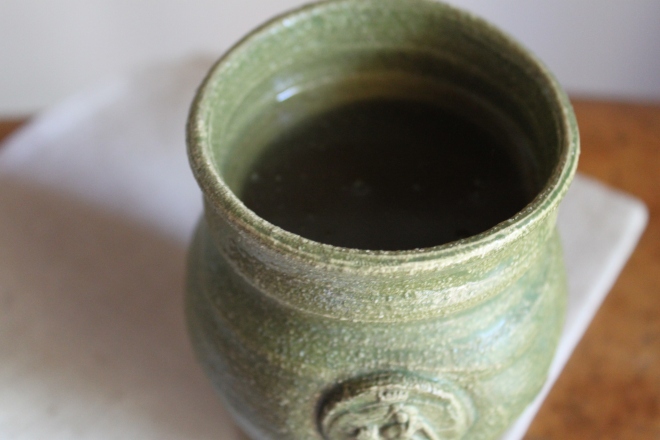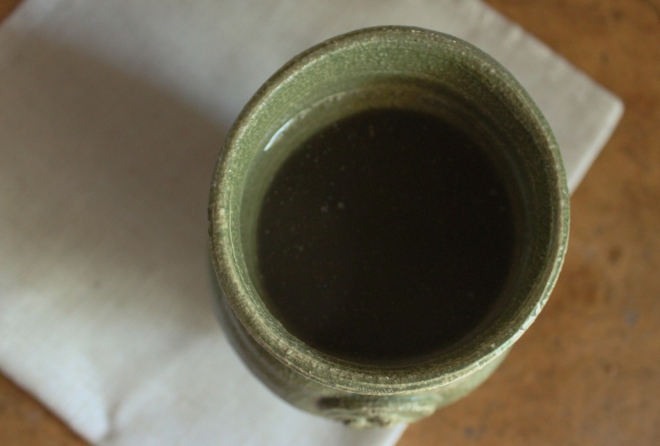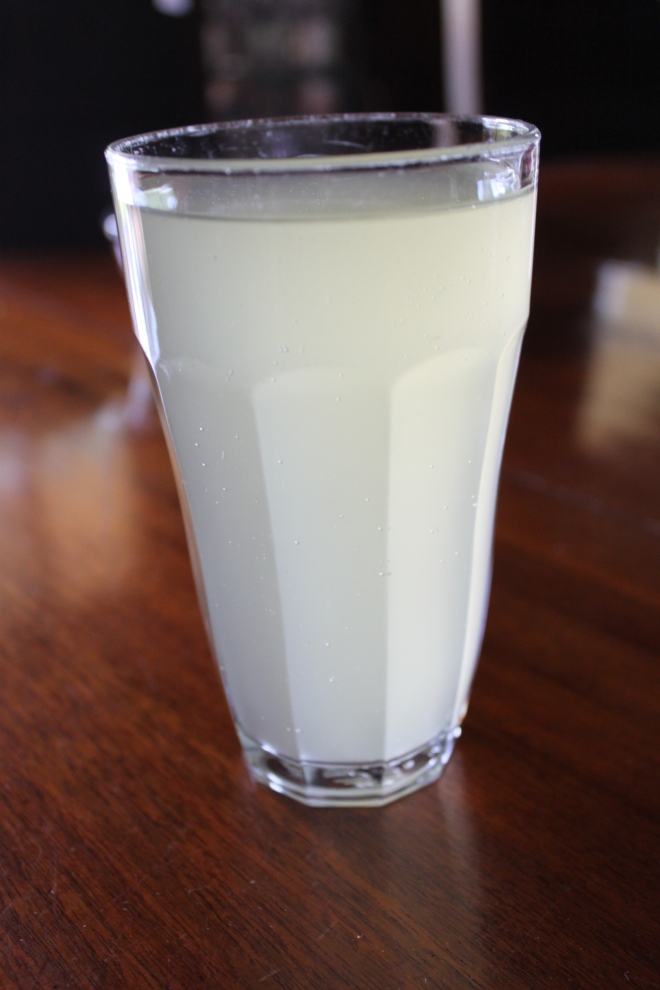This is the first of two posts on using experimental archaeology to study alcohol production in the past. In this post, I’m going to talk about why archaeologists study ancient brewing and one of the ways that archaeologists identify alcohol on sites in the past. The next post will look at an experimental reproduction of chicha, a type of corn beer, which is used to create comparative material for starch analysis.

Egyptian model of a brewery. The men on the left are mashing starter while the seated man is bottling the beer. Middle Kingdom, RC 483, Rosicrucian Egyptian Museum. Photo by the author.
In the past few decades, archaeologists have started to pay a lot more attention to alcoholic beverages such as wine and beer. In part, this is because we now have much better techniques for recovering and analysing even very small samples of residues from the inside of brewing containers. At the same time, archaeologists have also started to realise that alcohol plays important social roles and studying the production and consumption of alcoholic beverages can help us answer much bigger questions about state formation, social stratification, gender roles and the domestication of plants.
Traditionally, alcoholic drinks have been studied as part of historical diets mostly as an important source of calories, nutrients and water. Even though that is definitely the case, consumption is always about more than just survival; as Dietler says, “People do not ingest calories, or protein: rather, they eat food, a form of material culture subject to almost unlimited possibilities for variation …”.[1] Which foods we consider edible, what we think of as a complete meal, how we know when and where is appropriate to eat, and the order of foods in the meal all depend on your culture and social position.

Wine press in Shivta, Israel. The remains of processing facilities like this are one of the clearest signs of alcohol production at a site, but normally archeologists have to combine different types of evidence to make a convincing argument. צילום:ד”ר אבישי טייכר [CC BY 2.5 (http://creativecommons.org/licenses/by/2.5)], via Wikimedia Commons
Foods are particularly loaded with symbolism because they literally become part of us when we eat them. As such, they help us construct individual and group identities. As an example, just think about how different coffee orders signal different identities. Asking for a coffee in a diner is different from ordering a vanilla soy latte in a keep cup at Starbucks which is different from ordering a single-origin cold brew in a hipster cafe, and each order helps to signal membership in a different group identity.
Brian Hayden has argued that through providing feasts, some people were able to control access to alcohol and so to leverage the group identity that was created by sharing it for political purposes.[2] He suggests that having extra grain at the end of the season allowed some individuals to make alcohol which could then be used to through feasts. When you throw a feast, the people who are invited are then obliged to give something back, either by inviting you to their own feast, or by providing labour or goods in return. This creates distinct classes of people, those who can afford to throw feasts and those who cannot. Different would-be leaders would compete to throw the best feasts, and to control the largest amount of labour (for large building projects like city walls, palaces etc.) or tribute in goods.

An example of a standard Late Uruk bowl (VA 15455) from Mesopotamia. It has been suggested that these bowls, which are ubiquitous in this period, were used to distribute rations of grain or perhaps bread. Licenced by the Staatliche Museen zu Berlin under CC BY-NC-SA 3.0 DE.
In other cases, the state produced and distributed alcohol as part of workers’ rations. Because food and drink are so essential to everyday life, controlling access to food and drink is a very effective form of social control.[3] Intensified state control of beer production has been identified in a number of ancient states including Mesopotamia, Egypt and Peru, and would have been a useful tool in centralising state power.[4]
Since alcohol clearly played an important role in ancient societies, it is important that archaeologists study it. However, recognising alcohol brewing and consumption on archaeological sites can be very difficult. For the most part, archaeologists rely on finding multiple lines of evidence, including equipment or installations for brewing, residue analysis, and plant remains. Finding just one of these elements, such as plant remains, might be evidence of lots of different practices but if we can find multiple types of evidence then that makes it more likely that people really were brewing or drinking alcohol there.
One of the ways that we can potentially identify brewing is through starch analysis. Starch grains are often left on tools and equipment that are used for preparing and serving plant-based foods and beverages, including alcohol. Starch analysis can be used to identify the type of grains, rhizomes or tubers that are present and sometimes even how they were prepared. Cooking, for example, causes the grains to burst and swell in distinctive ways although unfortunately, cooking also makes it harder to identify the type of grain!

Incan urpus or storage jar, 15th to 16th century. These jars were used for making, storing, and transporting chicha, among other things. Accession No. 1978.412.68. Licenced by the Metropolitan Museum under CC0 1.0 Universal.
In order to identify the starch grains and the preparation techniques used, it is important for archaeologists to have comparative samples which show what different grains look like, and how different preparation techniques (such as soaking, grinding, chewing, baking, boiling etc.) affect them. In the second post of this series, I’m going to walk you through how I made an experimental batch of chicha to make comparative samples.
[1] Dietler, “Food, Identity, and Colonialism,” 222.
[2] Hayden, “Feasting in Prehistoric and Traditional Societies.”
[3] Pollock, “Feasts, Funerals, and Fast Food in Early Mesopotamian States,” 18.
[4] Hastorf, “Gender, Space, and Food in Prehistory”; Jennings, “A Glass for the Gods and Gift to My Neighbor: The Importance of Alcohol in the Pre-Columbian Andes”; Joffe, “Alcohol and Social Complexity in Ancient Western Asia”; Pollock, “Feasts, Funerals, and Fast Food in Early Mesopotamian States.”
References
Dietler, Michael. “Food, Identity, and Colonialism.” In The Archaeology of Food and Identity, edited by Katheryn C Twiss, Occasional Paper No. 34., 218–42. Carbondale: Center for Archaeological Investigations, Southern Illinois University, 2007.
Hastorf, Christine A. “Gender, Space, and Food in Prehistory.” In Engendering Archaeology, edited by Joan M Gero and Margaret W Conkey, 132–59. Cambridge: Blackwell Publishing Ltd, 1991.
Hayden, Brian. “Feasting in Prehistoric and Traditional Societies.” In Food and the Status Quest: An Interdisciplinary Perspective, edited by Polly Wiessner and Wulf Schiefenhovel, 127–47. Providence: Oxford University Press, 1996.
Jennings, Justin. “A Glass for the Gods and Gift to My Neighbor: The Importance of Alcohol in the Pre-Columbian Andes.” In Alcohol in Latin America: A Social and Cultural History, edited by Gretchen Kristine Pierce and Áurea Toxqui, 25–45. Tucson: The University of Arizona Press, 2014.
Joffe, Alexander H. “Alcohol and Social Complexity in Ancient Western Asia.” Current Anthropology 39, no. 3 (June 1, 1998): 297–322. https://doi.org/10.1086/204736.
Pollock, Susan. “Feasts, Funerals, and Fast Food in Early Mesopotamian States.” In The Archaeology and Politics of Food and Feasting in Early States and Empires, 17–38. Springer, Boston, MA, 2003. https://doi.org/10.1007/978-0-306-48246-5_2.
















